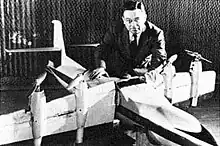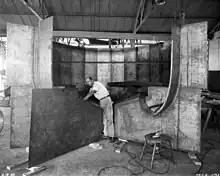Charles H. Zimmerman | |
|---|---|
 Zimmerman with a wind tunnel model | |
| Born | 1908 Olathe, Kansas, U.S. |
| Died | May 5, 1996 Hampton, Virginia, U.S. |
| Nationality | American |
| Education | University of Kansas degree in electrical engineering University of Virginia master's in aeronautical engineering 1954[1] |
| Occupation | Engineer |
| Spouse | Beatrice |
| Children | Charles H. Zimmerman, Craig S. Zimmerman |
| Engineering career | |
| Discipline | Aeronautical engineering |
| Institutions | National Advisory Committee for Aeronautics |
| Projects | Vought XF5U |
| Significant design | Vought V-173 |
| Awards | Wright Brothers Medal |
Charles Horton Zimmerman (1908 – May 5, 1996), was an aeronautical engineer, whose work on novel airfoil configurations led to several notable experimental aircraft programs.
Early work

Zimmerman worked at Langley Memorial Aeronautical Laboratory in the 1930s on a variety of research topics, including loads,[2][3][4] airfoils,[5][6] and aircraft stability and design.[7][8] During this time, he was also thinking about much more novel aspects of flight, especially how stability might be maintained. He theorized that the natural balancing reflexes of a person could be adequate to control very small flight vehicles, a concept he called "kinesthetic control". He was also interested in aspects that could lead to Vertical/Short Takeoff and Landing aircraft.
Novel Flight Vehicles
Zimmerman's research[5] posited aircraft having flat circular bodies, sans wings, as their lifting surface. In the 1940s, Zimmerman and the Navy began researching this idea, which led to the Vought XF5U, nicknamed the "flying pancake".
In 1953, Hiller Aircraft contracted with the Office of Naval Research to combine several research ideas, including Zimmerman's "kinesthetic" theory, to produce an airworthy "flying platform". The project was classified and conducted at Hiller's Advanced Research Division. In 1954, the prototype model 1031 was delivered. A 1956 Army contract produced the larger VZ-1 Pawnee.
Awards
- Wright Brothers Medal in 1956[9]
- Dr. Alexander Klemin Award in 1956 from the American Helicopter Society
References
- ↑ Saxon, Wolfgang (May 12, 1996). "Charles Zimmerman, 88, Dies; Designer of Innovative Aircraft". The New York Times. Archived from the original on November 20, 2021. Retrieved August 13, 2021.
- ↑ M. J. Bamber and C. H. Zimmerman (1933) Effect of stabilizer location upon pitching and yawing moments in spins as shown by tests with the spinning balance Archived 2016-03-03 at the Wayback Machine, NACA TN-474.
- ↑ M. J. Bamber and C. H. Zimmerman (1935) The aerodynamic forces and moments on a spinning model of the F4B-2 airplane as measured by the spinning balance Archived 2016-03-03 at the Wayback Machine, NACA TN-517.
- ↑ M. J. Bamber and C. H. Zimmerman (1936) Spinning characteristics of wings I : rectangular Clark Y monoplane wing Archived 2016-03-04 at the Wayback Machine, NACA TN-519.
- 1 2 C. H. Zimmerman (1933) Characteristics of Clark Y airfoils of small aspect ratios, NACA TN-431.
- ↑ C. H. Zimmerman (1935) Aerodynamic characteristics of several airfoils of low aspect ratio, NACA TN-539.
- ↑ C. H. Zimmerman (1936) An analysis of longitudinal stability in power-off flight with charts for use in design, NACA TN-521.
- ↑ C. H. Zimmerman (1936) Effect of changes in tail arrangement upon the spinning of a low-wing monoplane model, NACA TN-570.
- ↑ C. H. Zimmerman (1957) Some general considerations concerning VTOL aircraft, Society of Automotive Engineers paper number 570018.